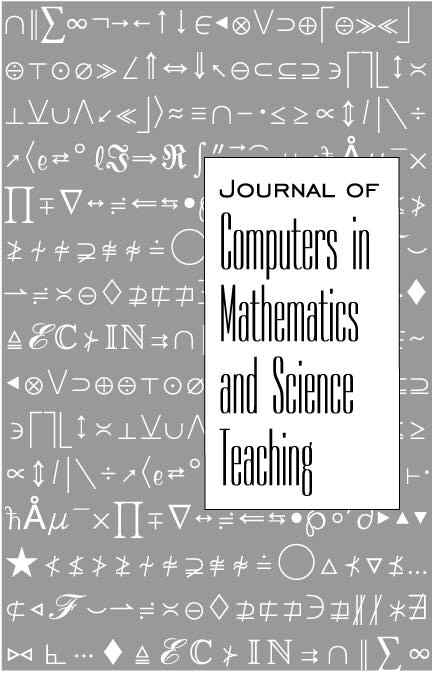
Ubiquitous wireless laptops in upper elementary mathematics
Article
Roy Clariana, Pennsylvania State University, United States
JCMST Volume 28, Number 1, ISSN 0731-9258 Publisher: Association for the Advancement of Computing in Education (AACE), Waynesville, NC USA
Abstract
This quasi-experimental investigation considers the second year of implementation of wireless laptops (1:1 ratio) in three 6th grade mathematics classrooms in one school compared to non-laptop classrooms (5:1 ratio) in seven other schools in the district. Comprehensive mathematics software from CompassLearning delivered via the internet was structured by the teacher to align to state standards and replaced the print-based textbook. The seven non-laptop schools accessed the same software using desktop computers in the classroom and lab. In the laptop classrooms, students moved at their own pace, students assumed responsibility for their own learning, the teacher’s role shifted substantially towards one-on-one interaction with each student, there was increased record-keeping to monitor student’s progress, and the teacher was more willing to give responsibility for learning to the student. Analysis of achievement data showed that the laptop students significantly out-scored the non-laptop students on the four Quarterly Benchmark examinations (effect sizes ranged from 0.47 to 0.90), but not on the state examination, though the laptop school’s relative rank in the district improved. The relationship between required benchmark testing and state tests is discussed and recommendations for future implementation are provided.
Citation
Clariana, R. (2009). Ubiquitous wireless laptops in upper elementary mathematics. Journal of Computers in Mathematics and Science Teaching, 28(1), 5-21. Waynesville, NC USA: Association for the Advancement of Computing in Education (AACE). Retrieved August 6, 2024 from https://www.learntechlib.org/primary/p/27026/.
© 2009 Association for the Advancement of Computing in Education (AACE)
Keywords
References
View References & Citations Map- ACOT (2005). Apple classrooms of tomorrow history. Retrieved March 4, 2008 from http://www.apple.com/education/k-12/leadership/acot/history.html
- ADS (2007). America’s Digital Schools 2006: A five-year forecast. A publication of the American Digital Schools Survey. Downloaded March 5, 2008 from http://21centuryconnections.com/node/117 Anderson, R.E. & Ronnkvist, A. (1999). The Presence of Computers in American Schools: Teaching, Learning, and Computing: 1998 National Survey,
- Beeland, W.D. (2002). Student engagement, visual learning and technology: Can interactive whiteboards help? Action Research Exchange, 1 (1), online. Downloaded March 5, 2008 from http://chiron.valdosta.edu/are/Artmanscrpt/Vol1no1/beeland_am.pdf
- Bernard, S. (2007). The Edutopia Poll: Should laptops replace textbooks? An active poll and post site. The George Lucas Foundation. Downloaded March 6, 2008 from http://www.edutopia.org/should-laptops-replace-textbooks Brown, R.S., & Coughlin, E. (2007). The predictive validity of selected benchmark assessments used in the Mid-Atlantic Region. (Issues& Answers Report, REL 2007–No. 017). Washington, DC: U.S. Department of Education, Institute of Educational Sciences, National Center for Education Evaluation and Regional Assistance, Regional Educational Laboratory Mid-Atlantic. Retrieved March 4, 2008 from http://ies.ed.gov/ncee/edlabs
- Clariana, R.B. (1992). The effects of public reports of progress on rate of lesson completion in computer-based instruction. Journal of Computing in Childhood Education, 3 (2), 127-136.
- Clariana, R.B., & Wallace, P.E. (2002). Paper-based versus computer-based assessment: Key factors associated with the test mode effect. British Journal of Educational Technology, 33 (5), 595-604.
- Dynarski, M., Honey, M., & Levin, D. (2002). Designing a study of the effectiveness of education technology: Background material for the first meeting of the Technical Working Group. (U.S. Department of Education, November 20-21, 2002)
- Bernard, S. (2007). The Edutopia Poll: Should laptops replace textbooks? An active poll and post site. The George Lucas Foundation. Downloaded March 6, 2008 from http://www.edutopia.org/should-laptops-replace-textbooks Freeman, D.J., & Porter, A.C. (1989). Do textbooks dictate the content of mathematics instruction in elementary schools? American Educational Research
- Lepper, M.R. (1985). Microcomputers in education, motivational and social issues. American Psychologist, 40, 1-18.
- Lowther, D.L., Ross, S.M., & Morrison, G.M. (2003). When each one has one: The influences on teaching strategies and student achievement of using laptops in the classroom. Educational Technology Research and Development, 51 (3), 23-44.
- Pitre, M. (1999). Integrating software into the mathematics curriculum. Curriculum Administrator, 35(4), 56-58.
- Remillard, J.T. (2005). Examining key concepts in research on teachers’ use of mathematics curricula. Review of Educational Research, 75 (2), 211-246.
- Rockman, S., Chessler, M., & Walker, L. (1998). Powerful tools for schooling: second year study of the laptop program. A report by the independent research firm Rockman et al. Funded by Microsoft Corporation. Downloaded March 4, 2008 from http://www.microsoft.com/Education/aalresearch2.mspx Schmidt, W.H., McKnight, C.C., & Raizen, S.A. (1997). A splintered vision: An investigation of U.S. Science and mathematics education. Dordrecht, The Netherlands: Kluwer.
- Sosniak, L.A., & Stodolsky, S.S. (1993). Teachers and textbooks: Materials use in four fourth-grade classrooms. Elementary School Journal, 93 (3), 249275.
- Windschitl, M., & Sahl, K. (2002). Tracing teachers’ use of technology in a laptop computer school: The interplay of teacher beliefs, social dynamics, and institutional culture. American Educational Research Journal, 39, 165-205.
These references have been extracted automatically and may have some errors. Signed in users can suggest corrections to these mistakes.
Suggest Corrections to ReferencesCited By
View References & Citations Map-
Connected Education: Teachers’ Attitudes towards Student Learning in a 1:1 Technology Middle School Environment
Tian Luo, Old Dominion University, United States; Alexander Murray, Ohio University, United States
Journal of Online Learning Research Vol. 4, No. 1 (February 2018) pp. 87–116
These links are based on references which have been extracted automatically and may have some errors. If you see a mistake, please contact info@learntechlib.org.
